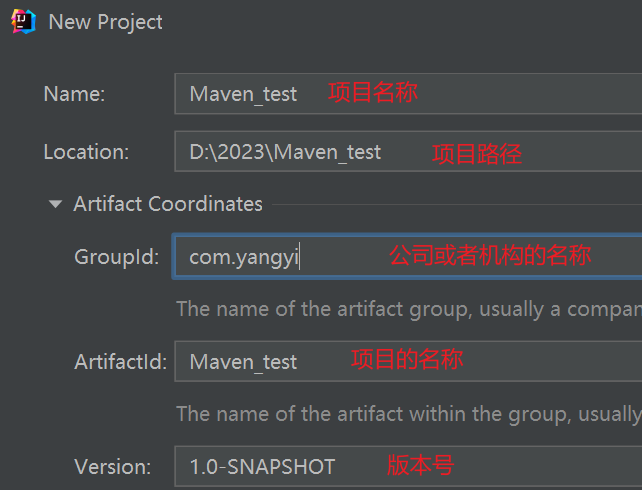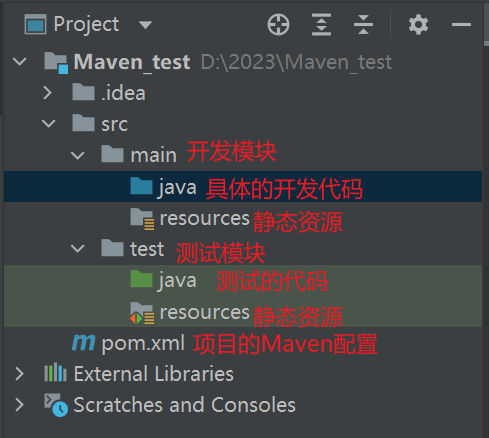Maven的基本使用
Maven的作用
- 管理项目引入的jar
- 方便将项目打包发布
- 方便项目的测试
Maven的安装配置
- Maven官网下载地址
- 配置环境变量
- 换源中央仓库
- 配置全局Maven配置文件
- 配置本地仓库地址
Maven的全局配置文件
<?xml version="1.0" encoding="UTF-8"?>
<!--
Licensed to the Apache Software Foundation (ASF) under one
or more contributor license agreements. See the NOTICE file
distributed with this work for additional information
regarding copyright ownership. The ASF licenses this file
to you under the Apache License, Version 2.0 (the
"License"); you may not use this file except in compliance
with the License. You may obtain a copy of the License at
http://www.apache.org/licenses/LICENSE-2.0
Unless required by applicable law or agreed to in writing,
software distributed under the License is distributed on an
"AS IS" BASIS, WITHOUT WARRANTIES OR CONDITIONS OF ANY
KIND, either express or implied. See the License for the
specific language governing permissions and limitations
under the License.
-->
<!--
| This is the configuration file for Maven. It can be specified at two levels:
|
| 1. User Level. This settings.xml file provides configuration for a single user,
| and is normally provided in ${user.home}/.m2/settings.xml.
|
| NOTE: This location can be overridden with the CLI option:
|
| -s /path/to/user/settings.xml
|
| 2. Global Level. This settings.xml file provides configuration for all Maven
| users on a machine (assuming they're all using the same Maven
| installation). It's normally provided in
| ${maven.conf}/settings.xml.
|
| NOTE: This location can be overridden with the CLI option:
|
| -gs /path/to/global/settings.xml
|
| The sections in this sample file are intended to give you a running start at
| getting the most out of your Maven installation. Where appropriate, the default
| values (values used when the setting is not specified) are provided.
|
|-->
<settings xmlns="http://maven.apache.org/SETTINGS/1.2.0"
xmlns:xsi="http://www.w3.org/2001/XMLSchema-instance"
xsi:schemaLocation="http://maven.apache.org/SETTINGS/1.2.0 http://maven.apache.org/xsd/settings-1.2.0.xsd">
<!-- localRepository
| The path to the local repository maven will use to store artifacts.
|
| Default: ${user.home}/.m2/repository
<localRepository>/path/to/local/repo</localRepository>
-->
<!-- interactiveMode
| This will determine whether maven prompts you when it needs input. If set to false,
| maven will use a sensible default value, perhaps based on some other setting, for
| the parameter in question.
|
| Default: true
<interactiveMode>true</interactiveMode>
-->
<!-- offline
| Determines whether maven should attempt to connect to the network when executing a build.
| This will have an effect on artifact downloads, artifact deployment, and others.
|
| Default: false
<offline>false</offline>
-->
<!-- pluginGroups
| This is a list of additional group identifiers that will be searched when resolving plugins by their prefix, i.e.
| when invoking a command line like "mvn prefix:goal". Maven will automatically add the group identifiers
| "org.apache.maven.plugins" and "org.codehaus.mojo" if these are not already contained in the list.
|-->
<pluginGroups>
<!-- pluginGroup
| Specifies a further group identifier to use for plugin lookup.
<pluginGroup>com.your.plugins</pluginGroup>
-->
</pluginGroups>
<!-- proxies
| This is a list of proxies which can be used on this machine to connect to the network.
| Unless otherwise specified (by system property or command-line switch), the first proxy
| specification in this list marked as active will be used.
|-->
<proxies>
<!-- proxy
| Specification for one proxy, to be used in connecting to the network.
|
<proxy>
<id>optional</id>
<active>true</active>
<protocol>http</protocol>
<username>proxyuser</username>
<password>proxypass</password>
<host>proxy.host.net</host>
<port>80</port>
<nonProxyHosts>local.net|some.host.com</nonProxyHosts>
</proxy>
-->
</proxies>
<!-- servers
| This is a list of authentication profiles, keyed by the server-id used within the system.
| Authentication profiles can be used whenever maven must make a connection to a remote server.
|-->
<servers>
<!-- server
| Specifies the authentication information to use when connecting to a particular server, identified by
| a unique name within the system (referred to by the 'id' attribute below).
|
| NOTE: You should either specify username/password OR privateKey/passphrase, since these pairings are
| used together.
|
<server>
<id>deploymentRepo</id>
<username>repouser</username>
<password>repopwd</password>
</server>
-->
<!-- Another sample, using keys to authenticate.
<server>
<id>siteServer</id>
<privateKey>/path/to/private/key</privateKey>
<passphrase>optional; leave empty if not used.</passphrase>
</server>
-->
</servers>
<!-- mirrors
| This is a list of mirrors to be used in downloading artifacts from remote repositories.
|
| It works like this: a POM may declare a repository to use in resolving certain artifacts.
| However, this repository may have problems with heavy traffic at times, so people have mirrored
| it to several places.
|
| That repository definition will have a unique id, so we can create a mirror reference for that
| repository, to be used as an alternate download site. The mirror site will be the preferred
| server for that repository.
|-->
<mirrors>
<!-- mirror
| Specifies a repository mirror site to use instead of a given repository. The repository that
| this mirror serves has an ID that matches the mirrorOf element of this mirror. IDs are used
| for inheritance and direct lookup purposes, and must be unique across the set of mirrors.
|
<mirror>
<id>mirrorId</id>
<mirrorOf>repositoryId</mirrorOf>
<name>Human Readable Name for this Mirror.</name>
<url>http://my.repository.com/repo/path</url>
</mirror>
-->
<!-- 默认的中央仓库 -->
<mirror>
<id>maven-default-http-blocker</id>
<mirrorOf>external:http:*</mirrorOf>
<name>Pseudo repository to mirror external repositories initially using HTTP.</name>
<url>http://0.0.0.0/</url>
<blocked>true</blocked>
</mirror>
<!-- 设置镜像仓库 -->
<mirror>
<!-- id:设置镜像仓库的ID -->
<id>aliyun maven</id>
<!-- mirrorOf:设置该镜像仓库代替哪个仓库 -->
<mirrorOf>central</mirrorOf>
<!-- name:设置镜像仓库的名称 -->
<name>aliyun maven</name>
<!-- url:设置镜像仓库的地址 -->
<url>https://maven.aliyun.com/nexus/content/repositories/central/</url>
</mirror>
</mirrors>
<!-- profiles
| This is a list of profiles which can be activated in a variety of ways, and which can modify
| the build process. Profiles provided in the settings.xml are intended to provide local machine-
| specific paths and repository locations which allow the build to work in the local environment.
|
| For example, if you have an integration testing plugin - like cactus - that needs to know where
| your Tomcat instance is installed, you can provide a variable here such that the variable is
| dereferenced during the build process to configure the cactus plugin.
|
| As noted above, profiles can be activated in a variety of ways. One way - the activeProfiles
| section of this document (settings.xml) - will be discussed later. Another way essentially
| relies on the detection of a system property, either matching a particular value for the property,
| or merely testing its existence. Profiles can also be activated by JDK version prefix, where a
| value of '1.4' might activate a profile when the build is executed on a JDK version of '1.4.2_07'.
| Finally, the list of active profiles can be specified directly from the command line.
|
| NOTE: For profiles defined in the settings.xml, you are restricted to specifying only artifact
| repositories, plugin repositories, and free-form properties to be used as configuration
| variables for plugins in the POM.
|
|-->
<profiles>
<!-- profile
| Specifies a set of introductions to the build process, to be activated using one or more of the
| mechanisms described above. For inheritance purposes, and to activate profiles via <activatedProfiles/>
| or the command line, profiles have to have an ID that is unique.
|
| An encouraged best practice for profile identification is to use a consistent naming convention
| for profiles, such as 'env-dev', 'env-test', 'env-production', 'user-jdcasey', 'user-brett', etc.
| This will make it more intuitive to understand what the set of introduced profiles is attempting
| to accomplish, particularly when you only have a list of profile id's for debug.
|
| This profile example uses the JDK version to trigger activation, and provides a JDK-specific repo.
<profile>
<id>jdk-1.4</id>
<activation>
<jdk>1.4</jdk>
</activation>
<repositories>
<repository>
<id>jdk14</id>
<name>Repository for JDK 1.4 builds</name>
<url>http://www.myhost.com/maven/jdk14</url>
<layout>default</layout>
<snapshotPolicy>always</snapshotPolicy>
</repository>
</repositories>
</profile>
-->
<!--
| Here is another profile, activated by the system property 'target-env' with a value of 'dev',
| which provides a specific path to the Tomcat instance. To use this, your plugin configuration
| might hypothetically look like:
|
| ...
| <plugin>
| <groupId>org.myco.myplugins</groupId>
| <artifactId>myplugin</artifactId>
|
| <configuration>
| <tomcatLocation>${tomcatPath}</tomcatLocation>
| </configuration>
| </plugin>
| ...
|
| NOTE: If you just wanted to inject this configuration whenever someone set 'target-env' to
| anything, you could just leave off the <value/> inside the activation-property.
|
<profile>
<id>env-dev</id>
<activation>
<property>
<name>target-env</name>
<value>dev</value>
</property>
</activation>
<properties>
<tomcatPath>/path/to/tomcat/instance</tomcatPath>
</properties>
</profile>
-->
<!-- 在已有的profiles标签中添加profile标签,限定maven项目默认的jdk版本 -->
<profile>
<id>myjdk</id>
<activation>
<activeByDefault>true</activeByDefault>
<jdk>1.17</jdk>
</activation>
<properties>
<!-- 配置编译代码的JDK版本 -->
<maven.compiler.source>1.17</maven.compiler.source>
<maven.compiler.target>1.17</maven.compiler.target>
<maven.compiler.compilerVersion>1.17</maven.compiler.compilerVersion>
</properties>
</profile>
</profiles>
<!-- activeProfiles
| List of profiles that are active for all builds.
|
<activeProfiles>
<activeProfile>alwaysActiveProfile</activeProfile>
<activeProfile>anotherAlwaysActiveProfile</activeProfile>
</activeProfiles>
-->
<!-- 让增加的 profile生效 -->
<activeProfiles>
<activeProfile>myjdk</activeProfile>
</activeProfiles>
</settings>
创建Maven项目
- Maven项目各个字段的含义
- Groupld(开发项目的组织名称)、Artifactld(项目名称)、Version(版本)三个字段共同唯一标识一个Maven项目

- JAVA-Maven项目的结构

- Maven项目配置文件
使用maven插件将项目打包为jar
- 将springboot项目打包为jar
<build>
<plugins>
<plugin>
<groupId>org.apache.maven.plugins</groupId>
<artifactId>maven-shade-plugin</artifactId>
<version>1.4</version>
<configuration>
<createDependencyReducedPom>true</createDependencyReducedPom>
</configuration>
<executions>
<execution>
<phase>package</phase>
<goals>
<goal>shade</goal>
</goals>
<configuration>
<transformers>
<transformer
implementation="org.apache.maven.plugins.shade.resource.ManifestResourceTransformer">
<mainClass>com.yangyi.tiShiNeng.TiShiNengApplication</mainClass>
</transformer>
</transformers>
</configuration>
</execution>
</executions>
</plugin>
<plugin>
<groupId>org.springframework.boot</groupId>
<artifactId>spring-boot-maven-plugin</artifactId>
<executions>
<execution>
<goals>
<goal>repackage</goal>
</goals>
</execution>
</executions>
</plugin>
</plugins>
</build>
<?xml version="1.0" encoding="UTF-8"?>
<project xmlns="http://maven.apache.org/POM/4.0.0"
xmlns:xsi="http://www.w3.org/2001/XMLSchema-instance"
xsi:schemaLocation="http://maven.apache.org/POM/4.0.0 http://maven.apache.org/xsd/maven-4.0.0.xsd">
<modelVersion>4.0.0</modelVersion>
<!--groupId:项目的公司名或者机构名-->
<groupId>com.yangyi</groupId>
<!--artifactId:项目的名称-->
<artifactId>Maven_test</artifactId>
<!--version:项目的版本-->
<version>1.0-SNAPSHOT</version>
<!--packaging:项目打包的方式,默认为jar-->
<packaging>jar</packaging>
<properties>
<!--配置项目编译的版本-->
<maven.compiler.source>8</maven.compiler.source>
<maven.compiler.target>8</maven.compiler.target>
</properties>
<!--dependencies:在这里配置管理导入的jar包-->
<dependencies>
<!--dependency:这里导入具体的jar包-->
<dependency>
<!--groupId:jar包的公司名或者组织名-->
<groupId>junit</groupId>
<!--artifactId:jar包的名称-->
<artifactId>junit</artifactId>
<!--version:jar包的版本-->
<version>3.8.1</version>
<!--scope:配置jar包的作用范围-->
<scope>test</scope>
<!--optional:配置该jar是否能被传递引用,默认false,表示可以被传递引用,true表示不可以-->
<optional>false</optional>
<!--exclusions:在这里配置排除不使用的jar-->
<exclusions>
<!--exclusion:这里配置具体不使用的jar-->
<exclusion>
<!--groupId:jar的组织名-->
<groupId>junit</groupId>
<!--artifactId:jar的名称-->
<artifactId>junit</artifactId>
</exclusion>
</exclusions>
</dependency>
</dependencies>
</project>
Maven项目的手动编译,测试,打包,安装,清理
-
需要配置环境变量,在CMD下执行,需切换到项目对应的目录下
-
编译命令:
mvn compile- 编译命令主要是将项目main模块的java代码编译为class字节码
-
测试命令:
mvn test- 测试命令的主要作用是将项目的test模块java代码编译为class字节码,并执行进行验证
-
打包命令:
mvn packge- 打包命令的主要作用是将编译号的class字节码文件打包为jar文件
-
安装命令:
mvn install- 安装命令主要是将打包好的jar文件提交到本地仓库
-
清理命令:
mvn clear- 清理命令的主要作用是将以上命令操作产生的target目录删除清理,还原到最初开始的状态
Maven项目中的依赖
-
直接依赖
- 在当前项目的Maven配置文件pom.xml引入的jar包属于直接依赖
-
间接依赖
- 使用引入jar包中Maven配置文件pom.xml引入的jar属于间接依赖
Maven中依赖冲突
- 引用了多个Maven项目或一个Maven项目引用了多个同名的jar包就会出现依赖冲突
解决方法
- 路径优先
- 在多个Maven项目相互引用时,引用深度层级浅的优先级高
-
声明优先
- 特殊优先
- 可选依赖
- 在配置文件中设置不允许被上一级Maven项目引用,只能在当前项目中使用
- 依赖排除
- 在配置文件中主动配置不使用的子级项目引用的jar包
Maven项目的依赖传递
Maven引入依赖作用范围
- 通过scope标签指定作用范围
| scope标签参数 | 主代码 | 测试代码 | 打包 | 范例 |
|---|---|---|---|---|
| compile(默认) | Y | Y | Y | log4j |
| test | N | Y | N | junit |
| provide | Y | Y | N | servlet-api |
| runtime | N | N | Y | jdbc |
使用maven插件将项目打包为jar
- 将springboot项目打包为jar
<build>
<plugins>
<plugin>
<groupId>org.apache.maven.plugins</groupId>
<artifactId>maven-shade-plugin</artifactId>
<version>1.4</version>
<configuration>
<createDependencyReducedPom>true</createDependencyReducedPom>
</configuration>
<executions>
<execution>
<phase>package</phase>
<goals>
<goal>shade</goal>
</goals>
<configuration>
<transformers>
<transformer
implementation="org.apache.maven.plugins.shade.resource.ManifestResourceTransformer">
<mainClass>com.yangyi.tiShiNeng.TiShiNengApplication</mainClass>
</transformer>
</transformers>
</configuration>
</execution>
</executions>
</plugin>
<plugin>
<groupId>org.springframework.boot</groupId>
<artifactId>spring-boot-maven-plugin</artifactId>
<executions>
<execution>
<goals>
<goal>repackage</goal>
</goals>
</execution>
</executions>
</plugin>
</plugins>
</build>
